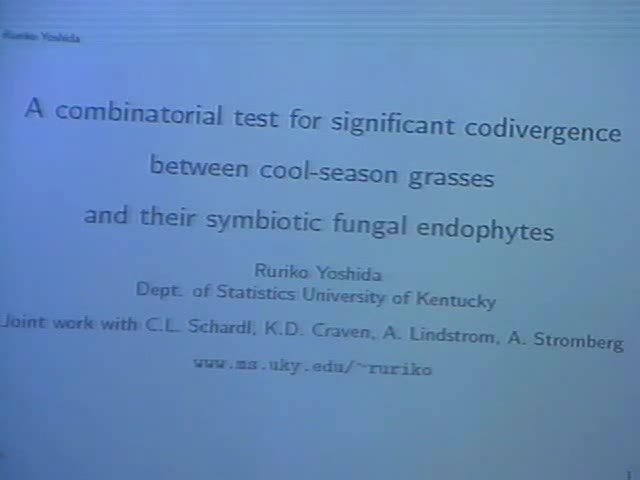A Combinatorial Test for Significant Codivergence Between Cool-season Grasses and their Symbiotic Fungal Endophytes
Presenter
March 9, 2007
Abstract
Symbioses of grasses and fungal endophytes constitute an
interesting model
for evolution of mutualism and parasitism. Grasses of all
subfamilies can
harbor systemic infections by fungi of the family
Clavicipitaceae. Subfamily
Poöideae is specifically associated with epichloë
endophytes (species
of Epichloë and their asexual derivatives, the
Neotyphodium
species) in
intimate symbioses often characterized by highly efficient
vertical
transmission in seeds, and bioprotective benefits conferred by
the
symbionts to their hosts. These remarkable symbioses have been
identified
in most grass tribes spanning the taxonomic range of the
subfamily. Here we
examine the possibility of codivergence in the phylogenetic
histories of
Poöideae and epichloë. We introduce a method of analysis to
detect significant codivergence even in the absence of strict
cospeciation, and to address problems in previously developed methods. Relative ages
of
corresponding cladogenesis events were determined from
ultrametric maximum
likelihood H (host) and P (parasite = symbiont) trees by
an algorithm
called MRCALink (most recent common ancestor link), an
improvement over
previous methods that greatly weight deep over shallow H and
P node
pairs.
We then compared the inferred correspondence of MRCA ages in
the H and
P trees to the spaces of trees estimated from 10,000 randomly
generated
H and P tree pairs. Analysis of the complete dataset, which
included a
broad host-range species and some likely host transfers
(jumps), did not
indicate significant codivergence. However, when likely host
jumps were
removed the analysis indicated highly significant codivergence.
Interestingly,
early cladogenesis events in the Poöideae corresponded to
early
cladogenesis
events in epichloë, suggesting concomitant origins of the
Poöideae and
this unusual symbiotic system.
This is joint work with C. L. Schardl, K. D. Craven, A.
Lindstrom, and
A. Stromberg.
